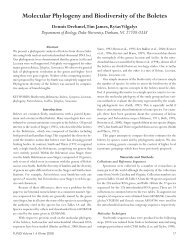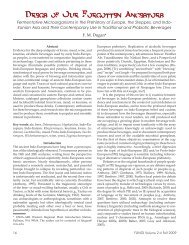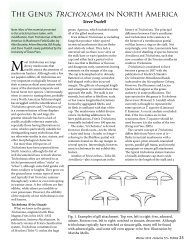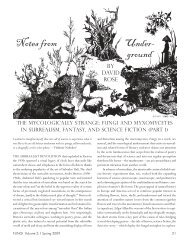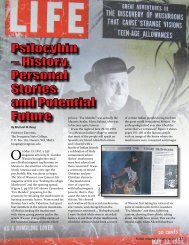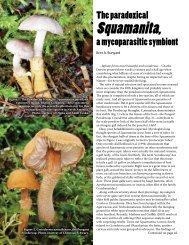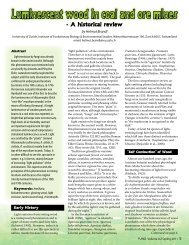FAlSE TRUFFlES OF NEwFOUNdlANd ANd LAbRAdOR
FAlSE TRUFFlES OF NEwFOUNdlANd ANd LAbRAdOR
FAlSE TRUFFlES OF NEwFOUNdlANd ANd LAbRAdOR
You also want an ePaper? Increase the reach of your titles
YUMPU automatically turns print PDFs into web optimized ePapers that Google loves.
stem holds it above ground and moss,<br />
so that dropping spores can be borne<br />
afield by passing air currents. Going<br />
underground, this mechanism is no<br />
longer advantageous. Truffles become<br />
irregular round balls with the sporulating<br />
surface on the inside. However, the<br />
mycorrhizal habits of the “parent” species<br />
are maintained: truffles are mycorrhizal<br />
organisms, with tree or other plant<br />
partners.<br />
Despite their macroscopic,<br />
microscopic and evolutionary<br />
differences, truffles make a<br />
logical grouping, because<br />
most are alike in behavior.<br />
They live underground. They<br />
have mycorrhizal relationships<br />
with green plants: they feed<br />
the plants minerals and<br />
water, and in return get some<br />
sugars that plants produce<br />
via photosynthesis, thanks<br />
to chlorophyll. Remaining<br />
underground, they do not<br />
have access to the wind for<br />
spore dispersal, like many<br />
mushrooms with a stem.<br />
Instead, they emit strong odors,<br />
attracting animals to eat them<br />
and spread the spores around<br />
in their feces. The odor explains<br />
why one way to find truffles is<br />
to look for swarms of truffle<br />
flies, attracted to the fragrance,<br />
and why pigs and dogs are used<br />
to hunt them. The same odor is<br />
why we like them as well.<br />
“Truffleness” is an example<br />
of convergent evolution.<br />
Organisms from quite different<br />
evolutionary lines have<br />
independently discovered a<br />
similar way to make a living: go<br />
underground, partner up with a<br />
plant for food, produce spores<br />
inside your body, emit a smell<br />
to attract consumers to eat you<br />
and then disperse your spores<br />
to start the cycle anew.<br />
As with many mushrooms,<br />
European names have been<br />
applied to many North<br />
American truffles, which may<br />
turn out to be sister species<br />
unique to this continent. To<br />
date, at Foray Newfoundland<br />
& Labrador we have recorded truffles<br />
from the genera Alpova, Elaphomyces,<br />
Endogone, Hysterangium and Rhizopogon<br />
in our province. These genera, at least,<br />
are reasonably easy to tell apart by their<br />
macroscopic morphology. Identification of<br />
truffles to species, however, is much more<br />
difficult. Truffler mercenaries come armed<br />
with microscope and chemicals, using<br />
both microscopic appearance and color<br />
reaction to chemicals to dissect out the<br />
Figure 2. Voucher pictures of Alpova sp., above, and<br />
Rhizopogon evadens, below. Again note the obvious<br />
glebal difference between the two genera. These shots<br />
taken some hours after collection show that Alpova<br />
darkens with time more than Rhizopogon. Photo:<br />
Roger Smith.<br />
species. Unfortunately, even this attack<br />
is repelled by some of our truly cryptic<br />
species, which can only be separated by<br />
their DNA. Analysis of genetic marker<br />
sequences by two of the authors (JH, TH)<br />
was used to identify our species of Alpova<br />
and Rhizopogon.<br />
Alpova<br />
Alpova is a relative of the gilled bolete<br />
genus Paxillus, and is mycorrhizal<br />
with deciduous trees,<br />
mostly species of Alnus.<br />
In outward appearance,<br />
Alpova is indistinguishable<br />
from Rhizopogon, but the<br />
two genera are readily<br />
differentiated by cross<br />
section (Figures 1-2). The<br />
context of Alpova is solid,<br />
alternating between a<br />
darkening gelatinous material<br />
and a firmer ivory-colored<br />
stroma, giving it a marbled<br />
appearance.<br />
Our Alpova collections<br />
range from Pasadena on the<br />
west coast of Newfoundland<br />
through coastal Labrador and<br />
up to its northern interior.*<br />
All were associated with<br />
Alnus viridis ssp. crispa,<br />
and all clustered together<br />
as a single species, close to<br />
Alpova diplophloeus, but<br />
sufficiently removed from it<br />
genetically to form a distinct<br />
genetic species. DNA (but<br />
not the truffle) has been<br />
recovered from a soil sample<br />
from Alaska, suggesting that<br />
it is likely a northern species<br />
of wide distribution on this<br />
continent. As stated in our<br />
preliminary report (Hayward,<br />
2011), we are still working on<br />
the nature of this species.<br />
Elaphomyces<br />
Elaphomyces (Figure 3,<br />
page 14) is a mycorrhizal<br />
partner of conifers, and our<br />
only true truffle, although<br />
not the prized edible. Its<br />
outer shell, the peridium,<br />
is hard and thick; inside<br />
is a white spore mass that<br />
* Note to puzzled Californians: Pasadena is a community on the shore of Deer Lake, near the west coast of Newfoundland, named by<br />
its founder after his wife’s birthplace (Pasadena, California, naturally).<br />
FUNGI Volume 4:5 Winter 2011<br />
13



